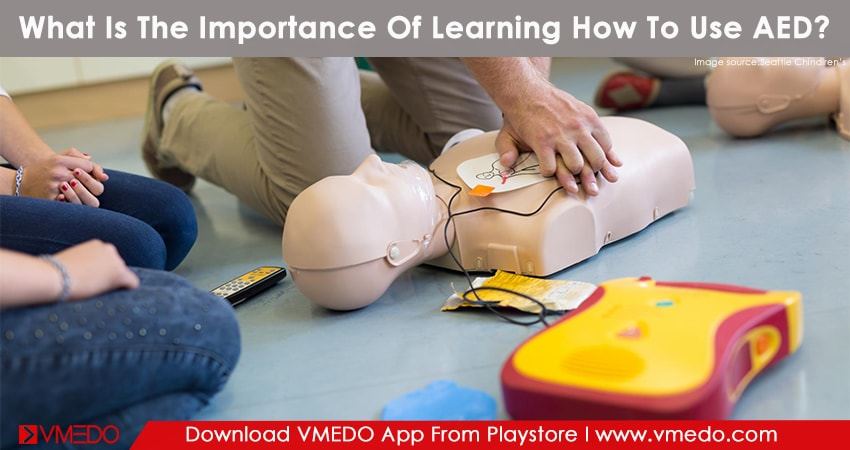If you are wondering what AED is and how is it helpful in first aid you’re not alone. a lot of people are unaware of this simple portable device which is used for treating sudden cardiac and heart attacks to restore normal functioning of your cardiac system
AED or Automated external defibrillator is a portable, BATTERY-OPERATED DEVICE THAT IS USED TO MEASURE THE RHYTHM OF THE HEART DURING CARDIAC ARRESTS AND PROVIDE SHOCKS IF NECESSARY to restore the normal pace and functioning of the heart.
What is the importance of learning how to use AED?
Cardiac arrests are very sudden, without proper emergency response in the initial 10-12 minutes the patient may suffer a variety of conditions like stroke and even death. In India, every 1 in 10 person dies from cardiac arrests and nearly 85% of the cardiac arrests happen outside the hospital which is a scary statistic. that’s why learning the measures to get help or help someone during cardiac arrests become important.
What is fibrillation and defibrillation?
Before learning what defibrillation is we should understand fibrillation, During fibrillation, the heart’s two small upper chambers don’t beat the way they should. Instead of beating in a normal pattern the atria beat irregularly and too fast . this causes the heart muscles to twitch due to this blood clots will be formed which increases the risk of having the stroke
Now, defibrillation is a process in which shock will be passed to the heart to restore this irregular beating to the right speed.
AED components

These are the most important external features of an AED
- ON-OFF Button
- It is used for switching the device power supply on or off.
- Electro pads
- Electro pads are used to attach on the patient’s body to deliver the shock
- Screen and a speaker
- Screen and a speaker is provided on AED so that it becomes easy for the first responder to use it easily in the times of emergency
- Shock button
- AED after observing the heart rhythm will instruct if the shock should be given or not if it asks for a shock this button is to be used.
- Battery
- To reset the heart rhythm we require a large voltage up to 800volts . to provide that a powerful battery comes with AED.
- How does an AED work?
- cardiac arrests the electro pads will be connected to the patient’s body, AED reads the electric signals and understands the rhythm of the heart. if the rhythm is upset it will understand how many current needs to be supplied to make it right. After providing the shock once, it measures the rhythm again, if it is still upset it understands again how much amount of current needs to supply if the rhythm had gone back to normal it instructs us not to give shock again. It works in a feedback loop where it constantly monitors heart and understands the required measures.
- Precautions to be taken while using AED.
- Avoid touching the patient after connecting the electrodes to get proper readings.
- Avoid touching the patient while providing shock.
- The electric paddles used in the procedure should not be placed
- On a woman’s breasts
- Over an internal pacemaker patients
- Before the paddle is used, a gel must be applied to the patient’s skin.
How to use AED step by step guide
- After checking the scene and ensuring that the person needs help, you should ask a bystander to call an ambulance for help.
- Turn on the AED and follow the visual and/or audio prompts.
- Open the person’s shirt and wipe his or her bare chest dry. If the person is wearing any medication patches, you should use a glove (if possible) hand to remove the patches before wiping the person’s chest.
- Attach the AED pads, and plug in the connector (if necessary).
- Make sure no one is, including you, is touching the person. Tell everyone to “stand clear.”
- Push the “analyze” button (if necessary) and allow the AED to analyze the person’s heart rhythm.
- If the AED recommends that you deliver a shock to the person, make sure that no one, including you, is touching the person – and tell everyone to “stand clear.” Once clear, press the “shock” button.
- Begin CPR after delivering the shock. Or, if no shock is advised, begin CPR. Perform 2 minutes (about 5 cycles) of CPR and continue to follow the AED’s prompts. If you notice obvious signs of life, discontinue CPR and monitor breathing for any changes in condition.
Where do I learn how to use AED and CPR
First aid training is to be made compulsory at all offices and schools giving rise to awareness among the general public on the importance and the need for first aid. CPR and AED training are conducted by VMEDO as a part of their mission to enable and make people be confident first responders and good samaritans. These first aid trainings are open to all and they are conducted by trained and experienced personnel who are well versed in the emergency first aid sector.
Where do I buy AED in India?
At VMEDO we take care of all your needs, including procuring the best quality instruments available in India. If you want to buy an AED whether it is a training AED or a functional AED . Give us a call at 9343180000 or mail us at corporate@vmedo.com

